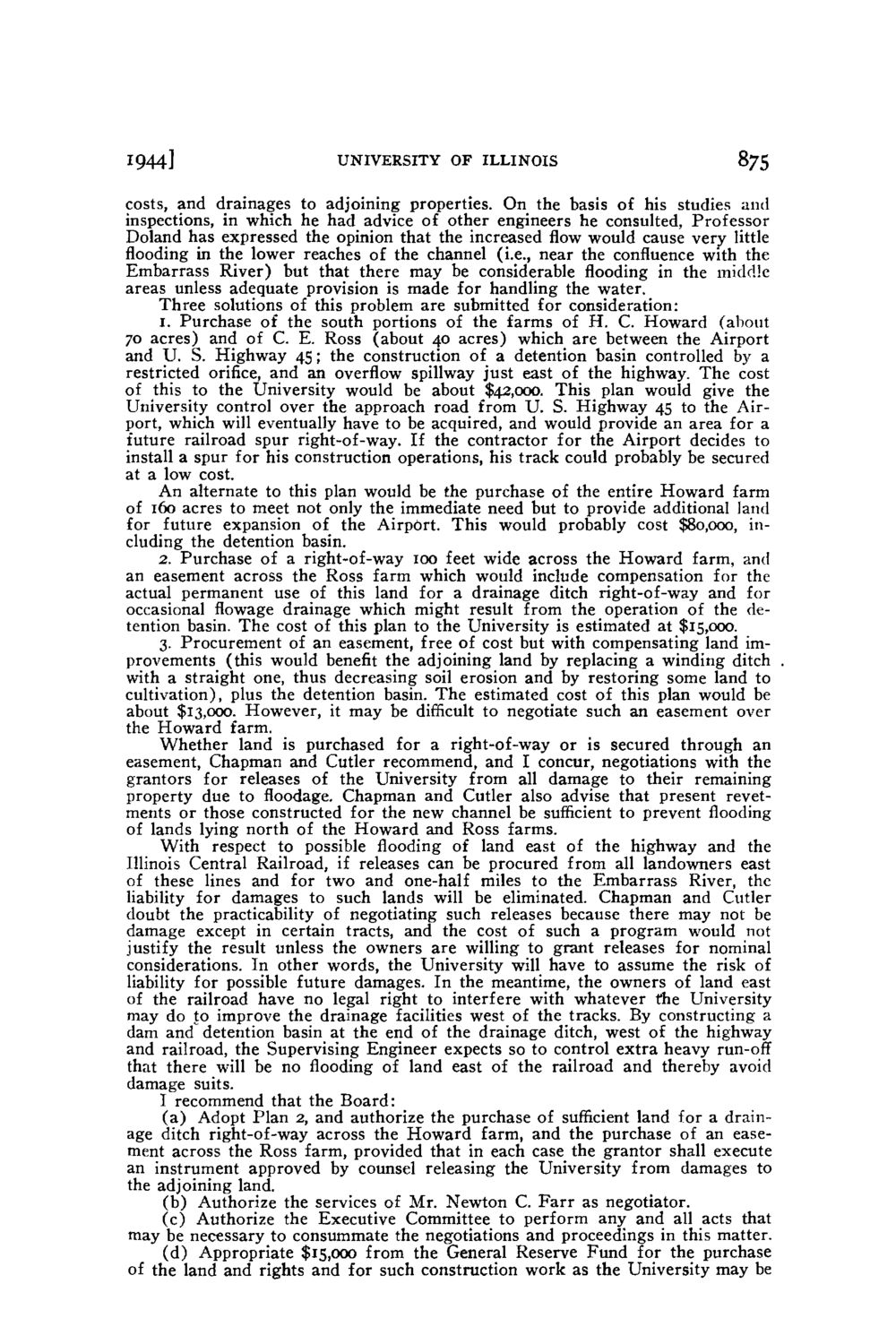| |
| |
Caption: Board of Trustees Minutes - 1944
This is a reduced-resolution page image for fast online browsing.

EXTRACTED TEXT FROM PAGE:
1944] UNIVERSITY OF ILLINOIS 875 costs, and drainages to adjoining properties. On the basis of his studies and inspections, in which he had advice of other engineers he consulted, Professor Doland has expressed the opinion that the increased flow would cause very little flooding in the lower reaches of the channel (i.e., near the confluence with the Embarrass River) but that there may be considerable flooding in the middle areas unless adequate provision is made for handling the water. Three solutions of this problem are submitted for consideration: 1. Purchase of the south portions of the farms of H . C. Howard (about 70 acres) and of C. E. Ross (about 40 acres) which are between the Airport and U. S. Highway 4 5 ; the construction of a detention basin controlled by a restricted orifice, and an overflow spillway just east of the highway. The cost of this to the University would be about $42,000. This plan would give the University control over the approach road from U. S. Highway 45 to the Airport, which will eventually have to be acquired, and would provide an area for a future railroad spur right-of-way. If the contractor for the Airport decides to install a spur for his construction operations, his track could probably be secured at a low cost. An alternate to this plan would be the purchase of the entire Howard farm of 160 acres to meet not only the immediate need but to provide additional land for future expansion of the Airport. This would probably cost $80,000, including the detention basin. 2. Purchase of a right-of-way 100 feet wide across the Howard farm, and an easement across the Ross farm which would include compensation for the actual permanent use of this land for a drainage ditch right-of-way and for occasional flowage drainage which might result from the operation of the detention basin. The cost of this plan to the University is estimated at $15,000. 3. Procurement of an easement, free of cost but with compensating land improvements (this would benefit the adjoining land by replacing a winding ditch with a straight one, thus decreasing soil erosion and by restoring some land to cultivation), plus the detention basin. T h e estimated cost of this plan would be about $13,000. However, it may be difficult to negotiate such an easement over the H o w a r d farm. Whether land is purchased for a right-of-way or is secured through an easement, Chapman and Cutler recommend, and I concur, negotiations with the grantors for releases of the University from all damage to their remaining property due to floodage. Chapman and Cutler also advise that present revetments or those constructed for the new channel be sufficient to prevent flooding of lands lying north of the H o w a r d and Ross farms. With respect to possible flooding of land east of the highway and the Illinois Central Railroad, if releases can be procured from all landowners east of these lines and for two and one-half miles to the Embarrass River, the liability for damages to such lands will be eliminated. Chapman and Cutler doubt the practicability of negotiating such releases because there may not be damage except in certain tracts, and the cost of such a program would not justify the result unless the owners are willing to grant releases for nominal considerations. In other words, the University will have to assume the risk of liability for possible future damages. In the meantime, the owners of land east of the railroad have no legal right to interfere with whatever fhe University may do to improve the drainage facilities west of the tracks. By constructing a dam and detention basin at the end of the drainage ditch, west of the highway and railroad, the Supervising Engineer expects so to control extra heavy run-off that there will be no flooding of land east of the railroad and thereby avoid damage suits. I recommend that the Board: ( a ) Adopt Plan 2, and authorize the purchase of sufficient land for a drainage ditch right-of-way across the H o w a r d farm, and the purchase of an easement across the Ross farm, provided that in each case the grantor shall execute an instrument approved by counsel releasing the University from damages to the adjoining land. (b) Authorize the services of Mr. Newton C. F a r r as negotiator. (c) Authorize the Executive Committee to perform any and all acts that may be necessary to consummate the negotiations and proceedings in this matter. (d) Appropriate $15,000 from the General Reserve Fund for the purchase of the land and rights and for such construction work as the University may be
| |